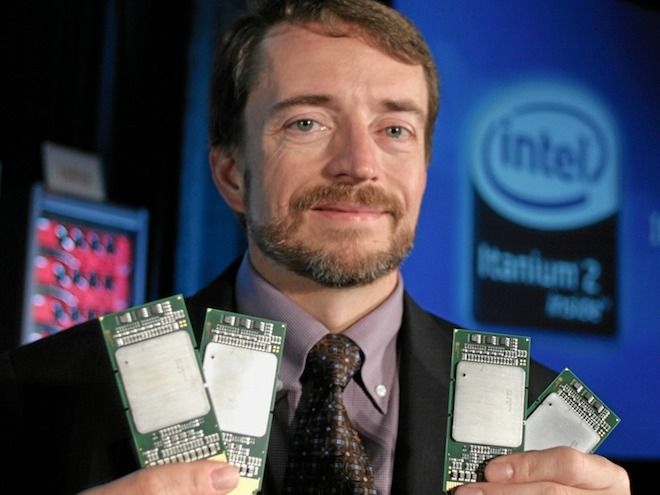Intel Appoints Pat Gelsinger as New CEO, From Feb 15th
by Dr. Ian Cutress on January 13, 2021 9:41 AM EST
News is breaking that Intel has announced that Pat Gelsinger, CEO of VMWare, is to take the role of CEO at Intel from February 15th.
Intel today has released a press statement saying that current CEO Bob Swan (who we interviewed only a few days ago!) is to step down in his role, and be succeeded by Pat Gelsinger. Gelsinger, a veteran of the industry, has spent over 40 years at companies such as VMWare, EMC, and spent 30 years previously at Intel, reaching the potisition of Chief Technology Officer. In that role he drove creation of standards such as USB, Wi-Fi, he was the architect of the 80486, and played key roles in 14 generations of Intel Core and Xeon processors. As CEO of VMWare since 2012, Pat has overseen a tripling of annualized revenue to make VMWare a recognized global leader in global infrastructure and cyber security.
Rumors of Intel getting a new CEO have never died down, even since Bob Swan officially took the role from Brian Krzanich in January 2019. Through those two years, Swan has seen successive YoY growth in the companies revenue streams, as well as a turnover of high-profile technical personnel, such as Dr. Murthy Renduchintala. The goal has seemingly been to push Intel into more areas for TAM growth, while at the same time push through the fundamental issues surrounding the delays to manufacturing on the 10nm node, which has been delayed for a couple of years at this point, and the 7nm node, to which delays were announced more recently. The missing piece of the puzzle has been having an engineer at the top of Intel's food chain, particularly one well versed in Intel's product portfolio, and for those that wanted this to happen, it appears to be so, from February 15th.
Bob Swan will still head the Intel financial call on January 21st, where the company is set to announce how it will approach its future process node strategy, namely 7nm, in light of recent delays. This call should indicate how much Intel is set to invest in its own manufacturing facilities, and how much it may offload to third party foundries during that timeframe. During our interview with Bob Swan, he mentioned that Intel would only work with third party foundries if it could get preferential treatment for the volumes it needed, as well as integration with all related design tools. Swan also stated that licensing a process node technology from someone else for use in Intel's fabs was also an option the company could be considering. No word has been given as to Bob's future, if this is retirement from Intel, or what future role he may play.
On the new CEO news, the chairman of the board at Intel, Omar Ishrak, has said,
“The board and I deeply appreciate Bob Swan for his leadership and significant contributions through this period of transformation for Intel,” continued Ishrak. “Under his leadership, Intel has made significant progress on its strategy to transform into a multi-architecture XPU company to capitalize on market shifts and extend Intel’s reach into fast-growing markets. Bob has also been instrumental in reenergizing the company’s culture to drive better execution of our product and innovation roadmap. He leaves Intel in a strong strategic and financial position, and we thank him for his ongoing guidance as he works with Pat to ensure the leadership transition is seamless.”
On the announcement, Pat Gelsigner has said,
“I am thrilled to rejoin and lead Intel forward at this important time for the company, our industry and our nation,” said Gelsinger. “Having begun my career at Intel and learned at the feet of Grove, Noyce and Moore, it’s my privilege and honor to return in this leadership capacity. I have tremendous regard for the company’s rich history and powerful technologies that have created the world’s digital infrastructure. I believe Intel has significant potential to continue to reshape the future of technology and look forward to working with the incredibly talented global Intel team to accelerate innovation and create value for our customers and shareholders.”
Gelsinger is set to oversee the next generation of Intel products and manufacturing. This includes 10nm, 7nm, Alder Lake, future Lakes, Sapphire Rapids, discrete graphics, Ponte Vecchio, networking, packaging, IoT, infrastructure, artificial intelligence, and 5G compute.
It is unclear at this time if Gelsinger will be a voice on the financial call on January 21st. $INTC is already up +9% on the news of the new CEO today (as of 9:54am ET).
Source: Intel

Pat Gelsinger in his CTO role, with Intel Itanium 2
Update: Gelsinger has released a note to Intel employees. It reads as follows.
I am thrilled and humbled to be returning to Intel as CEO. I was 18 years old when I joined Intel, fresh out of the Lincoln Technical Institute. Over the next 30 years of my tenure at Intel, I had the honor to be mentored at the feet of Grove, Noyce and Moore. Intel then helped me continue my education at Santa Clara University and Stanford University. The company also gave me the opportunity to work on the forefront of silicon innovation with the best and brightest talent in the industry.My experience at Intel has shaped my entire career, and I am forever grateful to this company. To come back “home” to Intel in the role of CEO during what is such a critical time for innovation, as we see the digitization of everything accelerating, will be the greatest honor of my career.I have tremendous regard for the company’s rich history and the powerful technologies created here that have transformed, and continue to transform, the world’s digital infrastructure. We have incredible talent and remarkable technical expertise that is the envy of the industry.I look forward to working with all of you to continue to shape the future of technology. While Intel’s history is rich, the transformation from a CPU to multi-architecture XPU company is exciting and our opportunity as a world-leading semiconductor manufacturer is greater than it’s ever been. I will be sharing more in the near-term about my vision and strategy for Intel, but I know we can continue to accelerate innovation, strengthen our core business and create value for our shareholders, customers and employees.I want to extend my gratitude to Bob for his leadership and significant contributions to Intel through this critical period of transformation. I welcome his counsel and ongoing guidance through the transition period to make it as seamless as possible for our customers and all of you.I’m sure you will have many questions about what is to come, and I look forward to hearing them, even if I won’t have all the answers on day one. I can’t wait to resume this journey with all of you.– Pat










161 Comments
View All Comments
GeoffreyA - Saturday, January 16, 2021 - link
'Tis a strange thing how computing then looked;If he had gotten his way, all Apple had been cooked
Global25 - Thursday, January 14, 2021 - link
Thanks for sharing this article,for world most efficient swimming pool heat pumps,contact <a href="https://poolheatpumps.in/">Global Interscope</a>Spunjji - Thursday, January 14, 2021 - link
This is really good news. He has a hell of a job ahead of him, but it feels like Intel have finally righted the wrong move they took when they passed him over the first time.Sad to see a lot of bullshit responses about Itanium in the comments, but so it goes!
Cullinaire - Thursday, January 14, 2021 - link
Well, people love to sound smart, even if whatever they write actually does the opposite. Not a big deal, truth always rises to the top!FunBunny2 - Friday, January 15, 2021 - link
"truth always rises to the top!"not with a willful enough liar and brain feeble minded listeners.
mode_13h - Friday, January 15, 2021 - link
I thought the Peter Principle told us that incompetence often rises to the top.Another tidbit I've heard (that, for all I know might have even played a role in Intel's manufacturing woes) referred to as the "bad news diode", in which bad news tends not to reach upper management, because it tends to gets filtered out and watered down at every step along the way.
I guess the way to counter that is for managers to somehow reward hearing bad news from their direct reports. You just want to set the rewards below those of successful execution, however. It should be like: "the only failure you really get in trouble for is the one you didn't warn me about, as soon as you could have known".
Oxford Guy - Friday, January 15, 2021 - link
"Not a big deal, truth always rises to the top!"If that were the case corporations wouldn't rule the Earth and the global ecology wouldn't be disintegrating.
grant3 - Friday, January 15, 2021 - link
I'm trying to figure out why people are so critical of the work he did on Itanium 2.Do they really think the Itanium ISA was poised for great success until Gelsinger torpedoed it with a terrible design?
Or are they just blindly criticizing anyone they see mentioned in the same sentence as "Itanium" without even pretending to understand that no amount of technical wizardry could have overcome the business forces that doomed the ISA?
Spunjji - Friday, January 15, 2021 - link
I think it's the latter. I was as derisive of Itanic as a *product-range* as the next person, but I'm also aware that the *design* wasn't really the problem. Intel produced something that didn't work out as well in practice as it did in theory and, in the process, out-competed themselves with their own mass-market designs. It happens!FunBunny2 - Friday, January 15, 2021 - link
"no amount of technical wizardry could have overcome the business forces that doomed the ISA?"history, of any aspect of human endeavor, tells us that the 'winner' is the one that captures the most minds, not the one that is technically superior.
X86 dominates due to a series of small, short sighted bean counter decisions:
- IBM wanted a Personal Computer, but didn't want to build it in house so they bought in parts
- IBM didn't want Moto's chip because Moto was big enough to drive a bargain, where Intel was up shit's creek without a paddle
- IBM didn't want to spend on 16-bit peripherals, so was invented the 8088
- Kapur 'cloned' VisiCalc for the 8088, but could afford to write to only of the PC's OS assemblers (C wasn't widely used, and when you 'upgraded' to the first C version, you had the fun of watching screens that used to snap just crawl by), and chose PC/DOS just because it was barely a control program and thus let him fiddle the hardware
- 1-2-3 made the IBM/PC and PC/DOS lava hot stuff in corporate, which led MicroSoft, et al to write yet more applications for the platform, in due time forcing out the others
- Novell Netware made wiring a office network feasible, thus forcing out department level mini-computer office applications, and in due time mini-computers as a class
- those looking for 'office work' got themselves a Clone and a purloined copy of 1-2-3 and a WP program thus exploding the demand for the 8088
- AMD proved that 64-bit extensions were 'good enough', so why bother with a better arch
- RISC turned out to be too much trouble at the ISA level, but perfect on the metal, ironic that
ask any hardware engineer what they think of the X86 architecture, and you'll get something like a sneer. but the industry makes due with a sub-par solution just because it's become too pervasive and expensive to mount an alternative. just look at *nix. a real set of OSs, but nearly invisible.